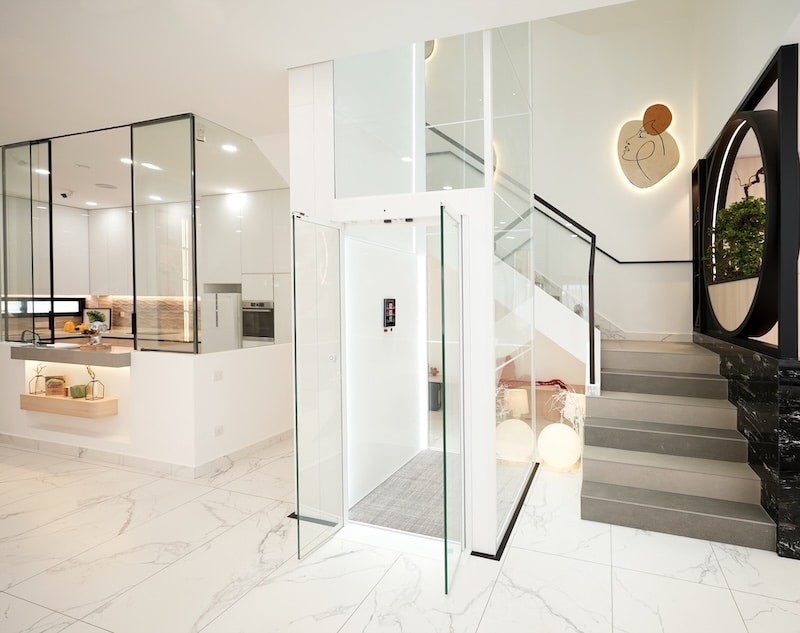
Compact home lifts are becoming more popular in Australia as people seek more effortless living and long-term accessibility. This trend is driven by aging populations, changing mobility needs, and modern home designs. Compact lifts provide an ingenious solution for small-space structures, enhancing property value. With real estate trends favoring mobility features, installing a compact home lift is convenient and a worthy investment.
Learn about the benefits and key factors when choosing the right home lift.
What are Compact Home Lifts?
Compact home lifts are miniature elevators that sacrifice space for a residential application. They are a fashionable mode of mobility that does not require a significant structural intervention. Unlike conventional elevators, they fit easily into existing spaces and are self-installed. With minimal upkeep and energy consumption, they make for a more economical choice.
Different types cater to various needs:
- Screw Driven Lifts: Use a drive nut and a drive screw, needing minimal space and offering a sleek design. They are quiet, energy-efficient, and ideal for homes with limited structural capacity.
- Hydraulic Lifts: Use a piston system for smooth movement, handling heavier loads. They need a small machine room but are reliable and comfortable.
- Traction-Based Lifts: These use a counterweight and pulley system, like commercial elevators, but in a compact format. They are durable, power-efficient, and operate smoothly.
Benefits Of Installing Small Lifts for Houses in Australia
- Improved Accessibility
A small house lifts makes movement easier for individuals with mobility challenges, and those planning for long-term independent living. It eliminates the struggle of using stairs, reduces the risk of falls, and improves overall comfort. Even for homeowners without mobility concerns, installing a lift ensures the home remains accessible in the future.
- Space-Saving Design
Unlike traditional elevators, compact lift for homes require minimal structural modifications. They fit into small spaces without major renovations, making them ideal for townhouses, apartments, and smaller properties. Their sleek and modern design blends seamlessly with home interiors while maximizing available living space.
- Increased Property Value
A home lift enhances market appeal and adds long-term value to a property. As accessibility becomes a priority, homes with lifts stand out to potential buyers. Whether selling in the future or planning to stay, a lift makes a property more desirable and future-proof.
- Energy Efficiency
Compact house lifts are designed for low energy consumption and quiet operation. Many models use efficient motors, LED lighting, and standby modes to reduce electricity use. This makes them an environmentally friendly solution that improves mobility without significantly increasing energy costs.
- Enhanced Safety Features
Compact lifts have essential safety features like emergency stop buttons, automatic braking, and backup power systems. Their smooth and stable operation ensures a comfortable ride, while advanced control mechanisms prevent sudden drops or jerks. These features provide homeowners with added peace of mind.
Compact Home Lift Installation Process in Australia
Step 1: Site Assessment & Consultation
A specialist evaluates the available space and home layout to determine the best lift options. This step ensures the lift is placed efficiently with minimal disruption. Homeowners also receive guidance on design, budget, and installation timelines.
Step 2: Choosing the Right Lift Model
After assessment, the ideal lift model is selected based on the home’s structure and the resident’s needs. Options include pneumatic, hydraulic, and traction-based lifts, each offering unique benefits. Custom finishes, door types, and control panels help match the home’s style.
Step 3: Pre-Installation Preparations
Before installation, necessary adjustments like minor structural changes and permit approvals are completed. In Australia, lifts must comply with national safety standards. Some homes may require modifications, such as floor reinforcement or ceiling adjustments.
Step 4: Lift Installation
Elevator installation takes 2 to 4 days with minimal disruption. Unlike traditional elevators, compact lifts are designed for easy integration. Many models have self-supporting structures, removing the need for complex pit or shaft installations.
Step 5: Final Testing & Safety Checks
The lift undergoes rigorous testing to meet Australian safety standards. Experts check emergency stop functions, backup power, and weight capacity. Homeowners receive a demonstration on safe use and maintenance before final approval. Once testing is complete, the lift is ready for everyday use.
Choosing The Best Compact Home Lift For Your Needs
Selecting the right compact home elevator involves considering key factors like space, capacity, speed, budget, and maintenance. With various models available, understanding these aspects helps make an informed decision.
-
Space Availability & Structural Requirements
Compact residential lifts fit small spaces, but requirements vary. Screw driven lifts need minimal changes, while hydraulic and traction models may require a shaft or machine room. Check ceiling height, floor strength, and access points before choosing.
-
Load Capacity & Number of Passengers
Weight capacity matters, especially for families or mobility aid users. Most compact elevators hold one to three passengers, supporting 150–400 kg. Choose a model that meets current and future needs.
-
Lift Speed & Energy Consumption
Home lifts don’t need high speed, but smooth travel is key. Energy-efficient motors, LED lighting, and standby modes help reduce electricity use and costs over time.
-
Budget & Long-Term Maintenance
Cost depends on the model, customization, and installation. Higher upfront costs mean lower maintenance expenses. Choose a reputable brand for reliable support and long-term performance.
-
Top Brands in Australia
Like SWIFT Lifts, top brands offer a variety of compact home elevators, from space-saving vacuum models to luxury hydraulic options. They provide reliable warranties, strong after-sales support, and energy-efficient designs. Comparing features and customer reviews helps find the best fit.
Price of Compact Home Lifts in Australia
- Average Price Range
Compact home lifts in Australia generally cost between $30,000 and $65,000. Basic models start at around $30,000, while high-end designs with advanced features can go up to $65,000 and more. These prices usually cover the lift but may not include installation and home modifications.
- Factors Affecting Cost
The type of lift is an essential determinant of cost. Generally, hydraulic lifts are less costly, and screw driven are more premium and expensive. Customizations such as high-end finishes, automatic doors, and touchscreen controls will increase the price. Installation costs will vary, depending on any alteration required in the home structure.
- Financing Options & Government Grants
Homeowners may be eligible for NDIS funding, state grants, or Home Care Packages to support accessibility improvements. Some lift providers also offer flexible payment plans, making it easier to manage costs over time. Checking with local authorities and lift suppliers can help identify the best funding options.
Compact Home Lifts Reviews: Why Choose Us
- Experienced Installation Team
SWIFT Lifts has extensive experience in elevator installations across Australia. Our experts ensure every installation meets local building codes. We focus on precision and quality to provide seamless solutions that enhance accessibility.
- High-Quality & Energy-Efficient Lifts
Our compact, durable, and energy-efficient elevators prioritize safety and reliability. Emergency stop functions, backup power, and smooth operation technology ensure a secure and comfortable experience.
- Quick & Hassle-Free Installation
Unlike traditional elevators, our compact lifts are installed in a few days with minimal disruption. Our streamlined process preserves your home’s design while ensuring a stress-free experience.
- Reliable Maintenance & Support
Regular servicing is key to long-term performance. We offer maintenance, troubleshooting, and repairs to keep your lift running smoothly. Our team is always available for expert support.
- Customer Satisfaction & Warranty
We stand by our lifts with strong warranties and dedicated after-sales support. Our commitment to excellence ensures a safe, stylish, and functional lift that enhances your home and lifestyle.
Conclusion – Future-Proof Your Home with a Compact Lift
A small house lifts are worth investing in for safety and long-term benefits. Indeed, life becomes easier when people move smoothly and efficiently between floors. These lifts take the weight off energy-efficient operation and advanced safety measures; they are designed into any living space quite seamlessly.
Upgrade your home today! Get a free consultation and expert advice on choosing the perfect lift. Visit SWIFT Lifts Australia to learn more.
FAQs
Compact home lifts are designed to fit in small spaces, making them ideal for townhouses and apartments. Most models require a floor area of around 1m² to 1.5m², depending on the lift type. Some lifts, like pneumatic models, do not need a shaft, reducing space requirements further.
Compact home lifts usually do not require council approval if they meet Australian Standards and Building Code requirements. However, some modifications may need a permit, especially if structural changes are involved. It’s always best to check with local authorities or your lift provider.
Modern home lifts are energy-efficient and cost very little to operate. Most models run on standard household power and consume the same energy as washing machines or microwaves. Standby modes and LED lighting further reduce energy consumption.
Installation is quick and hassle-free, typically taking 5 to 7 days. The exact time frame depends on the lift model and any necessary home modifications. Since compact lifts require minimal construction, disruption to your home is minimal.
Compact home lifts come with advanced safety features for smooth and secure operation. These include emergency stop buttons, battery backup for power outages, automatic door locks, and non-slip flooring. Some models also have sensors to prevent doors from closing if an obstacle is detected.
Get In Touch










